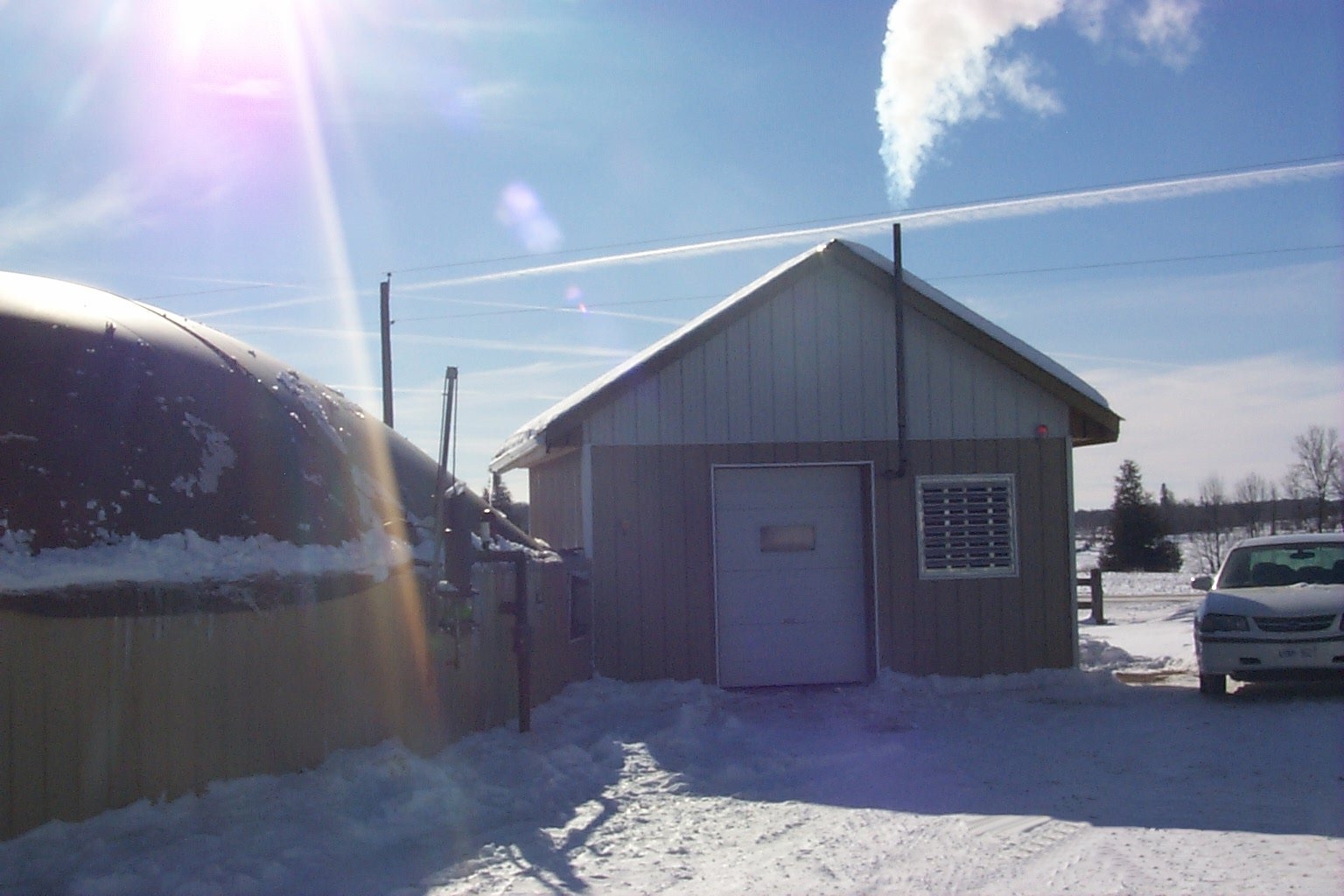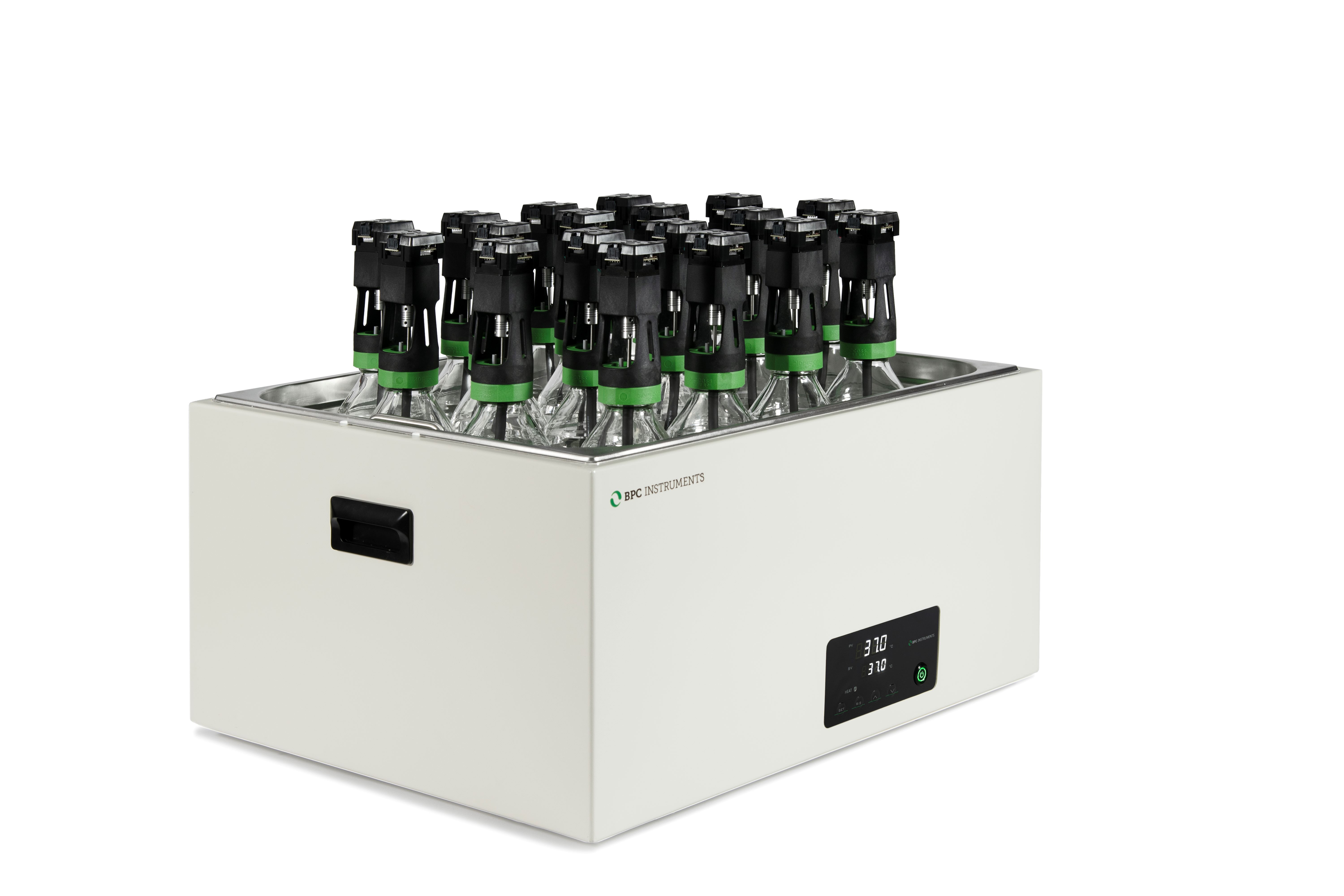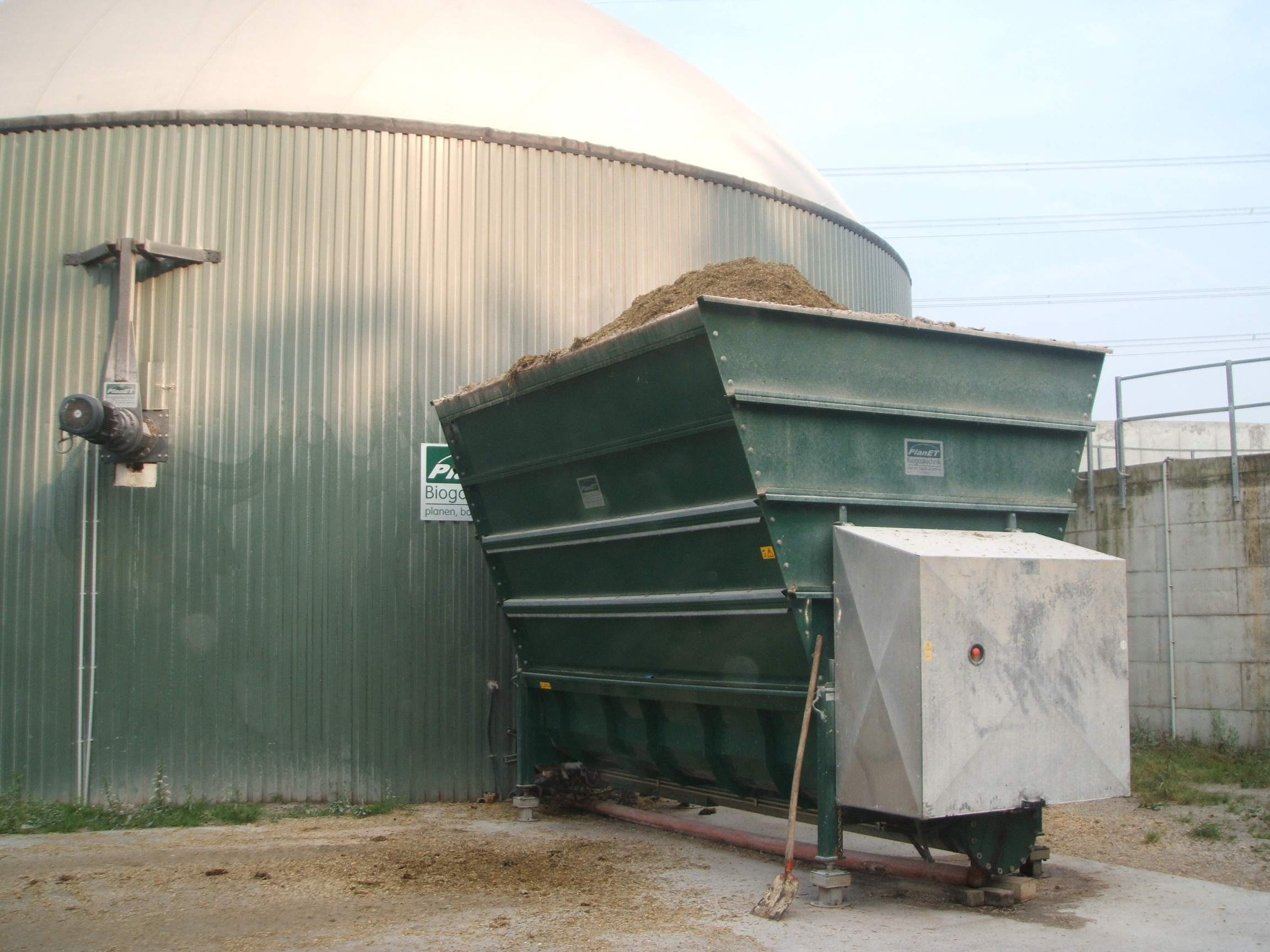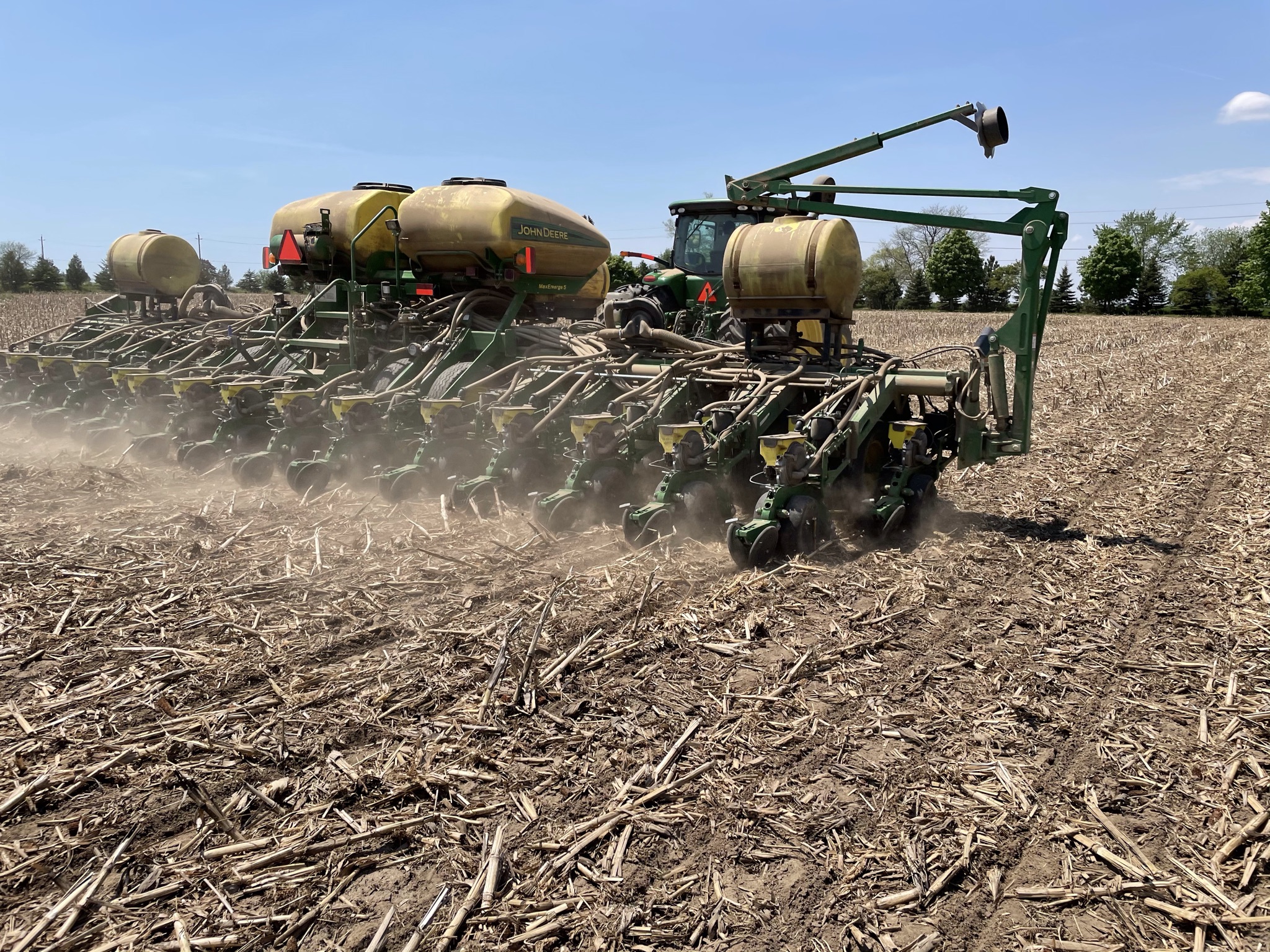Energy yields from a farm-based anaerobic digestion system
Learn what is required to calculate the type, amount and economic value of energy that could be produced from a farm-based anaerobic digestion system.
ISSN 1198-712X, Published June 2025
Introduction
Farm-based digesters have the capacity to efficiently produce electrical and heat energy from organic materials produced on and off the farm. This fact sheet provides information to calculate the type, amount and economic value of energy produced from a farm-based anaerobic digestion system. It also provides an example of an energy balance for a digester.
Farm-based anaerobic digestion system
A farm-based anaerobic digestion (AD) system is a sealed, heated container located on a farm that breaks down organic materials to produce biogas (Figure 1). This biogas (approximately 60% methane, CH4) is used to generate energy.

One feature of a farm-based AD system is the effluent from the digester (called digestate), which is usually spread on a local land base as a crop nutrient source. In some cases, digestate undergoes solid-liquid separation and the solid component of the digestate may be spread as a nutrient, used as a livestock bedding material or sold as a compost or bio-material.
Find more information on farm-based AD systems in the fact sheet, Anaerobic digestion basics.
Adding organic materials
Organic materials suitable for digestion fit into 3 categories:
- byproducts produced by a farming operation, including materials such as manure, bedding, feed waste, crop residues (stover or straw) and runoff from silos
- energy crops, including any crop grown for the purpose of producing energy. The most common crop used in digesters is corn silage. Other crops that could be used are grasses, forages or whole plant sugar beets
- off-farm source materials, includes materials from food processing plants, source-separated organics, grease trap residuals and other non‑agricultural source materials
The regulatory requirement for adding organic materials depends on the types and combinations of materials used. The Nutrient Management Act, 2002, includes a process allowing a regulated mixed anaerobic digestion facility to mix certain on-farm and off-farm materials together. Review the fact sheet, Regulatory requirements for regulated mixed anaerobic digestion facilities for more information.
In some circumstances, an Environmental Compliance Approval (ECA) or Renewable Energy Approval (REA) under the Environmental Protection Act, 1990 (EPA) may be required for the AD facility and for the application of the digested mixed materials on land.
Contact the Agriculture Information Contact Centre for more information on regulatory requirements at
Factors contributing to energy yield
The energy yield from an anaerobic digester depends on the material used to feed the digester. There are 5 characteristics of any feedstock that will affect the energy yield:
- dry matter content
- volatile solids content
- biogas output potential per tonne of volatile solids
- methane content in biogas
- inhibiting components in the feedstock
Dry matter content
The amount of available energy from a material rises with increased dry matter (DM) content. Dry matter is also referred to as “total solids” (TS). Materials with very low dry matter content (such as washwater or highly diluted manure) will have a very low (or negative) energy yield, that is, the energy required to heat the material for digestion may come close to or exceed the amount of energy produced by the digester. These materials may be used to dilute other materials with high dry matter content or if there is a financial incentive for treatment (a tipping fee).
Materials with a high dry matter content (>20% DM) require different operational practices for the digester. These materials have to be mixed with other, more dilute, incoming materials or mixed with recycled effluent from the digester. Consider alternative ways of harvesting energy instead of digestion, especially when the combustion of the material to produce heat in a biomass combustion system is >70% DM.
Most laboratories can perform dry matter content analysis. The free, online software Agrisuite provides estimates for dry matter content of farm-based materials.
Volatile solids content
In addition to the basic dry matter content, the ability of the material to break down effectively in the digester is important (for example, sand has a high dry matter content, but does not digest). Volatile solids (VS) are organic compounds of animal or plant origin and make up a proportion of the dry matter content. VS is sometimes called organic total solids (OTS). For digestible materials, higher VS content typically results in a higher biogas (energy) yield. Often, VS is specified as a percentage of DM content. For most materials used in farm-based AD systems, VS ranges from 63–98% of the dry matter in the material. Most laboratories in Ontario perform VS analysis.
For most farm-based anaerobic digesters, there is a recommended upper limit of VS loading per day. If this limit is exceeded, the digester will become more difficult to operate on a stable basis and problems such as poor biogas production or foaming could occur. This limit is expressed as kilograms of volatile solids per day per cubic metre of digester capacity (kg VS/day/m3). Values over 4.5 kg VS/day/m3 approach the operational limits of a digester, especially during start-up.
Biogas output per tonne of volatile solids
Biogas output is a measurement of biogas production within the time period the material is expected to be in the digester. A higher value of biogas output per tonne of VS gives a higher energy yield, which can vary greatly depending on the type and condition of the materials fed to the digester. Energy yields can range from 200–1,200 m3 of biogas per tonne of VS for specific materials used in a farm-based digester. There are published resources available (research journal articles, industry guidance materials) that outline potential biogas yields expected from various materials or substrates. However, it may be more useful to find information on biogas production from a similar digester operating with the same materials or from a lab that performs digestion tests to determine potential biogas production from specific materials. A biochemical methane potential (BMP) assay is a standardized method where potential biogas and methane yields are determined for individual materials or for the co-digestion of materials (Figure 2). Some laboratories in Ontario can perform BMP assay analysis.

Source: BPC Instruments.
Methane content in biogas
Biogas consists of methane (CH4), carbon dioxide (CO2), hydrogen sulphide (H2S), water vapour and other constituents. The methane content in biogas from agricultural sources typically ranges from 50–65%.
Inhibiting components in the feedstock
A variety of components in a feedstock can cause reductions in biogas production. In some manures, high nitrogen content could inhibit the digestion process, especially at higher operational temperatures. High nitrogen levels in swine and poultry manure can have this inhibiting effect. Materials such as copper sulphide or antibiotics in the feedstock may also inhibit digestion. Laboratory studies or knowledge from similar digesters running the same materials is often necessary to ensure proper operation.
Introducing new materials
Digestion is a biological process. It takes time for this process to adjust to a different material being introduced into the digester.
Before a new material is introduced, develop a plan for gradually introducing the material to the digester and steps to monitor digester performance and react to potential changes or upsets. For example, a plan could involve adding new materials starting with 10% of the full digester loading and gradually increasing to full loading in a 4–6-week period. The plan could also include instructions for slowing down the introduction of new materials and/or change agitation times if excessive foaming is detected in the digester.
Estimating biogas and energy yields from feedstock materials
Information is available in research journal articles and industry guidance materials to estimate potential biogas yields for many feedstock substrates and combinations of substrates. However, to obtain an accurate estimate of expected yields, contact a consultant familiar with the digester technology. The consultant will use lab tests (results from BMP assay analysis), results from similar facilities and experience to predict the yield. Table 1 is a summary of estimated biogas and energy yields calculated for three common feedstock materials.
| Material | Biogas yield per wet tonne of material (m3 biogas/t) | Electrical yield per wet tonne of material | Heat yield per wet tonne of material |
|---|---|---|---|
| Dairy manure | 23 | 48 | 62 |
| Corn silage | 180 | 335 | 425 |
| Bakery waste (average) | 265 | 490 | 630 |
Energy yield from livestock
Using Table 1, a basic estimate of biogas and energy production can be calculated. The following steps show the calculations needed for a dairy farm that has 140 milking cows (plus replacements). The calculations are for information purposes only. Individual assessment by qualified personnel is required for the final design of a facility.
Example
140 dairy cows plus replacements produce approximately 5,600 tonnes per year of manure (Agrisuite).
Electricity yield
5,600 tonnes/year × 48 kWh/tonne
= 269,000 kWh/year (approximately 730 kWh per day)
Heat yield
5,600 tonnes/year × 62 kWh
= 347,000 kWh per year (approximately 950 kWh per day)
On cold winter days, 50% of the heat might be required to maintain digester temperature. Therefore, on the coldest winter day, this translates to 475 kWh/day of surplus heat that may be available. At 3,413 British thermal units (BTU) per kWh, this would provide heat equivalent to a standard 100,000 BTU furnace for 16 hours.
Energy yield from adding off-farm source material
A farm-based digester can blend up to 50% off-farm source materials and work effectively. The following calculations are for the dairy farm example with the addition of 10% bakery waste.
- 560 tonnes/year of off-farm source material is added (10% of 5,600 tonnes of manure)
- Additional electricity yield: 560 tonnes/year × 490 kWh/tonne = 274,000 kWh per year
- Additional heat yield: 560 tonnes/year × 630 kWh/tonnes = 353,000 kWh per year
Total electricity generated from this AD system:
269,000 (manure) + 274,000 (bakery waste)
= 543,000 kWh/year (approx. 1,450 kWh/day)
Total heat yield generated from this AD system:
347,000 (manure) + 353,000 (bakery waste)
= 700,000 kWh/year
In this example, significantly more heat is produced from the mixed materials than is produced from manure only. In many circumstances on livestock farms, there is not sufficient use for all of this heat, particularly during the warmer months of the year.
Energy yield from energy crops
Some farm-based biogas systems in Ontario use energy crops as one of their feedstock materials to produce biogas. The primary crop used is corn silage. Figure 3 shows a hopper holding corn silage that will be fed into the AD system.

From Table 1, the following calculations are based on corn silage from 1 hectare of land:
- An average crop on good soils produces 45 tonnes of corn silage
- Electricity yield: 45 tonnes × 335 kWh per tonne = 15,000 kWh
- Total heat yield: 45 tonnes × 425 kWh per tonne = 19,000 kWh
- Usable heat yield = 19,000 × 25% = 4,750 kWh
This calculation assumes the farmstead uses 25% of the heat. Many cash crop farms will not have much opportunity to use this available heat.
Total usable energy yield/ha is 19,750 kWh (with heat recovery) or 15,000 kWh (without heat recovery).
This is the amount of energy available from 1 year’s worth of crops. To capture the electrical power, roughly 2 kW of electrical generation capacity is required to operate on a continuous basis to capture the 15,000 kWh of available power (assuming over 8,000 hours of operation per year).
Energy input versus output comparison
Energy is expended to produce renewable energy. Using corn silage as an example, the following inputs are required to grow, harvest, transport and digest 1 hectare of corn silage having a yield of 45 tonnes/hectare (Figure 4).
Energy used to produce and digest a crop:
- 940 kWh of energy in the 87.5 L of fuel used to grow, harvest and transport 1 hectare of corn silage
- 420 kWh of energy in the 42.3 m3 of natural gas required for the nitrogen to fertilize the crop
- 650 kWh of electricity is required to operate the digester
Total energy used = 2,010 kWh/hectare

Energy balance
The calculations indicate the total usable energy produced from 1 hectare of corn silage using an AD system is 19,750 kWh if some heat is used and 15,000 kWh if only the electricity value is captured. Therefore:
- 10.2% of the energy generated is required to produce and digest the crop (if both electricity and heat are captured)
- 13.4% of the energy generated is required to produce and digest the crop (if only electricity is captured)
These calculations do not take into account hidden energy uses, such as driving the farm truck or energy required to produce concrete.
Summary
Farm-based digesters have the capacity to efficiently produce electrical and heat energy from organic materials produced on and off the farm. However, careful assessment is required to ensure the materials used will produce energy in an economically viable and sustainable manner.
Author credits
This fact sheet was written by Jake DeBruyn, P. Eng., new technology integration engineer, Ministry of Agriculture, Food and Agribusiness (OMAFA), and Anna Crolla, P. Eng., energy and cropping systems engineer, OMAFA.
Footnotes
- footnote[1] Back to paragraph Extrapolated from information presented in Braun, R., and Wellinger, A., Potential of Co-digestion, IEA Bioenergy Task 37, 2003; and, Murphy, J., Braun, R., Weiland, P. and Wellinger, A., Biogas from Crop Digestion, IEA Bioenergy Task 37, 2010.
- footnote[2] Back to paragraph Assumes 35% conversion of biogas energy to electricity, 45% conversion of biogas energy to heat. Some of this heat is required to heat the digester. Electrical efficiency can vary from 25–42%.